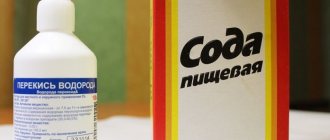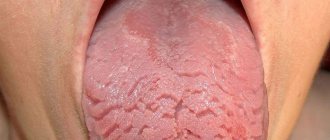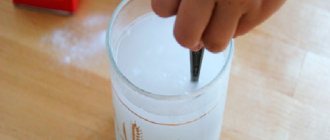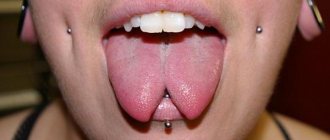It is impossible to say with complete certainty when this offal became desirable on the table and, moreover, scarce and high-status, but it is known for sure that peasants were forbidden to eat it; it was the privilege exclusively of gentlemen and people from high society.
Nowadays, this product is also an infrequent guest on the table, and traditionally dishes from it appear on the table on holidays. A lot of different dishes are prepared from beef tongue; it is used in first courses instead of regular meat; with its addition, salads are made, main courses and various gourmet snacks are prepared. Ready-made smoked, salted and marinated delicacies in various dressings are sold in store windows. But even without adding other ingredients, it is very tasty in itself and can be consumed as an independent product due to its rich, original taste. Beautifully chopped boiled tongue, neatly laid out on a plate with vegetables and herbs, will decorate any table.
Calorie content and composition of beef tongue
Beef tongue is valued not only for its high taste, it also has a unique composition. The product contains a balanced composition of protein, microelements, including sodium, potassium, iron, zinc and others, necessary for excellent well-being and full development of a person.
Depending on the methods of heat treatment, its calorie content changes:
- 100 grams of raw meat is approximately 173 kcal.
- Boiled will contain only 90 kcal.
- The calorie content of the stewed product will be 183 kcal.
Therefore, on a diet, it is better to eat it after cooking as a separate dish or by adding a light side dish of raw vegetables, and for heavy physical labor or intense training, it is recommended to stew it with the addition of healthy cereals.
Useful tips
Proper cleaning of beef tongue helps keep it soft and tender. However, in addition to the cleaning process, it is important to take into account other nuances that affect the taste of the product.
There are basic recommendations on how to get tasty and healthy ready-made beef tongue:
- It is advisable to buy meat chilled rather than frozen. Frozen food may be stale or old. If the tongue was bought fresh and frozen yourself, for subsequent cooking it is necessary to allow the meat to thaw naturally;
- Cook the chilled product for 12 hours. If the meat stays in the refrigerator longer, it will dry out and will not turn out soft and juicy;
- Boil the tongue for at least two hours;
- Cook the meat over low heat, covered, but leaving room for steam to escape;
- Peel the skin starting from the tip and moving towards the center.
Following these simple rules will help you prepare tender and tasty beef tongue, which can be served as a separate dish or used to make salads.
Selection of quality raw materials
No cooking method can correct the quality and taste of a stale, stale product, especially one with a “smell.” All the beneficial properties of the tongue are inherent only in fresh, high-quality meat. This is a product without signs of weathering, without spots and color unusual for meat - this is what the tongue should look like. By the way, the spots may be from the color of the animal’s tongue, but they cannot be confused with rottenness and signs of spoilage of the product.
An adult animal will have a very large tongue, but this may also be an indicator of old age. It will take a long time to cook.
More nutrients are found in the meat of an adult, but not an old animal. Veal, pork and lamb tongues are inferior in their benefits to beef, but are an alternative substitute due to their greater availability in stores and due to their lower cost.
Why do you need to clean your tongue?
When considering the question of how to get rid of white coating on the tongue, you need to start with the basics. The tongue of a healthy person should have a pink color, the surface should be elastic and slightly moisturized. At the same time, a light white coating is not considered a pathology, and this nuisance can be easily eliminated by ordinary cleaning. It's another matter when a strong coating appears. This may indicate the presence of a serious disease in the body.
Cleaning your tongue from plaque at home helps solve the following problems:
- Reduces the concentration of pathogenic bacteria in the oral cavity;
- Prevents the appearance of tartar and caries;
- Freshens breath;
- Improves the functioning of taste buds.
Useful properties of the product
Due to its rich composition, the condition of the skin improves, the immune system is strengthened, and most importantly, due to the high content of complete protein, this product is almost irreplaceable in the diet of children and pregnant women. Protein is responsible for building the muscle corset and is the main building material for a growing body. Lack of protein leads to muscular dystrophy and developmental disorders of the child's body. With a lack of protein in the diet, the skin, hair, and hormonal structure suffer.
Beef tongue is useful for anemia and during recovery after illness and surgery, as it contains a lot of iron.
There is an opinion that the tongue takes a long time to prepare. This is true if you cook it in the usual way. But almost every family has a multicooker and a pressure cooker, which reduces the need to control the cooking process to a minimum; the main thing is to choose the right mode . In a multicooker, the “stew” mode is suitable, but in a pressure cooker it’s even easier, just pour a little water into the bowl, put your tongue in and turn it on to the maximum setting. However, the list of beneficial properties of the tongue outweighs the cost and time spent on preparation, since the product:
- Contains a lot of minerals, including vitamins B, PP, zinc, which is rare in meat in such quantities. Iodine, potassium, phosphorus and iron are responsible for the production of hormones and amino acids.
- Promotes the body's production of insulin, which is important for diabetics.
- Responsible for tissue regeneration in postoperative patients.
- Makes the skin elastic.
- Does not contain connective tissue, making it easier to absorb for patients with gastritis and ulcers.
- Reduces blood cholesterol.
- It is an excellent product when dieting for weight loss, as it contains a lot of protein and little fat.
How to properly clean your tongue with an irrigator
Cleaning the tongue from plaque with an irrigator is carried out in compliance with the following rules:
- The procedure begins with a slight pressure, which gradually intensifies;
- The angle of impact of the jet should vary between 60-90 degrees;
- Duration of cleaning – 2-3 minutes;
- First, the general surface of the tongue is processed, then hard-to-reach areas;
- The procedure must be performed daily, at least once.
It is important to understand that the use of irrigators does not mean giving up mechanical brushing of teeth. Therapeutic liquids for the device are used strictly as prescribed by the doctor.
How to properly cook and clean beef tongue
There are several ways to cook a tongue.
First way
If the tongue is cooked for slicing, then pre-boiled water is poured into the pan, the tongue is put in, everything is brought to a boil and cooked over reduced heat for 10-15 minutes. Then the water in which the tongue was boiled is drained, clean boiling water is poured in, and cooked until ready. This is done so that, along with foam, unpleasant odors and dirt located on the rough surface of the hard skin of the product are removed from the tongue. During cooking, and the cooking time, depending on the weight and age of the animal, can reach up to 3 hours, you should monitor the water level so that it does not boil away, and add boiling water if necessary.
What to do after cooking?
Before you start peeling the skin off the beef tongue, you need to check the readiness of the offal.
It is advisable to clean your tongue immediately after it leaves the pan.
Place the product under cold water to make cleaning more convenient and the process goes faster. When removing the skin, follow these guidelines:
- remove the film from the thick part to the tip. In this case, large areas can be freed up. At the tip of the tongue, the skin comes off in small pieces;
- Make cuts with a sharp knife so that the surface remains smooth, without deep cuts. This is especially important if the offal is supposed to be used for cutting meat - in a salad this will not matter.
There is also a quick way. If you have a special board with a ribbed surface and clamps, then use the following instructions:
- Remove the tongue from the broth in which it was boiled.
- Place in a bowl of cold water.
- Secure it on a special board.
- Cut the skin at the base of the tongue.
- Pull the skin towards the tip of your tongue, as if you were taking off a sock.
- Cut off the remaining sections with a sharp knife.
How to properly clean your tongue
Step-by-step instructions for cleaning the product are as follows:
- Raw reeds need to be cleaned of dirt and mucus. It is advisable to pre-soak the offal in cold water; you can leave it overnight.
- Anything that gets wet should be cleaned off with a knife, scraping off the plaque and removing any remaining meat and salivary glands at the root.
- Rinse before storing in clean running water.
- Place in a saucepan, add boiling water and bring to a boil.
- Remove the foam, boil for 15 minutes and remove if the semi-finished product will be peeled at this stage. If it will be cleaned at the end of cooking, then reduce the heat, remembering to remove the foam with a slotted spoon, and simmer at a barely noticeable boil until done.
- If the skin is cleaned after preliminary boiling, then you should transfer the meat to cold water and wait until the moment when you can pick it up with your hand.
- Peel off the skin. It will have a white tint and easily move away from the main mass when prying it with a knife.
- If necessary, finish cooking by pouring clean boiling water and adding spices to taste.
What to peel raw and what to peel cooked?
In order for the beef tongue to be tender and have a pleasant taste, you need to clean it properly. The procedure is carried out in two stages.
- A raw tongue must be cleaned of dirt, mucus or remaining blood. Before this, the offal is soaked for at least half an hour, or better yet for an hour, in cold water. Anything that needs to be cleaned will become wet, making it much easier to remove waste from the surface of the tongue. After removing the meat from the water, pat it dry with a paper towel. Clean thoroughly, but with light movements, scraping off any unpleasant residue, while at the same time cutting off any remaining meat from the neck and fat, if any. Wash before cooking in running cold water. The skin remains uncovered for now.
- The second stage of cleaning takes place after the beef tongue has already been cooked. It is immersed in cold water, boiled after boiling for 15 minutes, the boiling water is drained, the pan and meat are washed. The next time it goes straight into fresh boiling water, where it cooks for 2.5-3.5 hours, depending on the size of the piece and how young the animal was. Together with it you can boil bay leaves, onions and carrots. You can add salt to the broth only at the last phase, when readiness is almost reached. Otherwise, the delicate product will turn into hard fibers.
We recommend: 16 unexpected ways to use toothpaste in everyday life
After the beef tongue is ready, place it directly from boiling water into cold water for a minute.
Advice
In order to check readiness, you need to pierce the offal with a knife. A clear liquid will be released from the finished tongue. If the meat is still damp, the liquid will be cloudy.
Further cleaning will be very easy: the skin begins to easily separate from the surface of the meat, you can pick it up in one place with a knife and pull it off almost entirely from the entire surface.
Advice
You can clean your tongue after cooking only until it cools down. If you leave the film, all you have to do later is cut it off with a knife.
We recommend: How to clean tripe!
Prevention of plaque formation on the tongue
- Brush your teeth and tongue at least twice a day;
- Include fermented milk products in your daily diet, eat more vegetables and fruits;
- Reduce the amount of spices, spicy and smoked foods you consume;
- Quit smoking and alcoholic beverages;
- Regularly undergo preventive examinations at the dentist;
- Do not cause diseases of the gastrointestinal tract.
Do I need to clean my tongue of plaque? Of course, even if we are talking about the physiological characteristics of the body. The film that appears on the tongue is traces of the vital activity of pathogenic bacteria, so if the plaque is left unattended, a favorable environment is created for the development of infectious diseases of the oral cavity.
Thanks to irrigators and other devices, taking care of your oral cavity is not at all difficult, and by spending just a few minutes a day, you can maintain a snow-white smile for many years.
Author of the article
List of required tools
Pork tongue, like beef tongue, can be cleaned raw or boiled. The second option is preferable, but in any case, the procedure will require a knife, a container of water and a metal scraper.
To clean your tongue with minimal loss of valuable meat, you must first boil it. Otherwise, a lot of pulp will be cut off along with the skin. And it will take much more time to clean.
If you purchased frozen tongue, you must first defrost it at room temperature. It is not recommended to speed up the thawing process using heat. Such manipulations negatively affect the structure of the pulp - it becomes dark and hard.
And it is best to buy a fresh product that has not been frozen. The age of the pig also plays a role; the younger it is, the more tender the meat will be.
Preparatory stage
How to cook pork tongues and peel them? Before cooking, the product must be washed and excess fat removed, because dishes made from it are already high in calories. Veins and other inedible parts should also be removed.
You should not peel the product raw, because it is difficult to do and you may lose some meat.
To get a truly delicious dish, you need to know:
- fresh tongue has a bright red color;
- if the product is fresh, it smells pleasant, a little sweet;
- Before cooking, you need to soak the product for several hours.
Cleaning your tongue with a tongue scraper
Nowadays, tongue scrapers take pride of place in the list of oral hygiene devices. Almost all of them are made of plastic and are a nozzle with a spoon-shaped tip. This excellent tongue and cheek remover needs to be replaced as often as toothbrushes. If you use it together with a rinse aid, the quality of the procedure will be one level higher. You can buy a tongue scraper at a pharmacy or order it from an online store.
How to remove the skin from beef tongue
Advice to housewives who read our site on how to quickly and easily remove the skin from the tongue. We will talk specifically about boiled beef tongue, since, unlike pork, it has especially thick and tough skin, which causes difficulties in removing it.
To easily remove the skin from the tongue, you need to cook the tongue for a long time and patiently until it is completely cooked. The cooking time for beef tongue depends on its size and the age of the animal. On average, the process takes 2-3 hours in a regular saucepan or 40-50 minutes in a pressure cooker (for details, see the recipe “how to boil beef tongue”).
Some housewives remove the skin from the tongue almost at the beginning of cooking, 15 minutes after the water boils in the pan, but this is inconvenient, and the process is not so simple (I can’t even imagine how to remove the skin from a raw tongue).
We recommend that immediately after the tongue has cooked and you have turned off the stove, carefully remove it from the hot broth and place it under a generous stream of cold water. The surface of the tongue will quickly cool down and the skin will come off effortlessly.
Benefits and harms
The very rich composition of vitamins in beef tongue is very beneficial for the human body. Let's list the benefits of such an offal:
- Improves the conductivity of nerve impulses.
- A low-calorie product is a dietary product.
- Helps produce insulin, which is useful for diabetes.
- Improves the condition of skin, nails and hair.
- Helps restore strength.
- Helps in wound healing and skin diseases.
Calorie content
| Property | Meaning |
| Calorie content, kcal | 173 |
| Proteins, g | 16 |
| Carbohydrates, g | 2,2 |
| Fats, gr | 12,1 |
Vitamins
| Vitamin | Meaning |
| Vitamin B1, mg | 0,12 |
| Vitamin B2, mg | 0,3 |
| Vitamin B6, mg | 0,2 |
| Vitamin B9, mcg | 6 |
| Vitamin E (TE), mg | 0,4 |
| Vitamin PP, mg | 7,7 |
| Vitamin B12, mcg | 4,7 |
| Vitamin B5, mg | 2 |
| Vitamin PP, mg | 4,8 |
Microelements
| Micro and macro element | Meaning |
| SFA - Saturated fatty acids, g. | 4,8 |
| Cholesterol, mg | 150 |
| Zola, Mr. | 0,9 |
| Water, city | 68,8 |
| Sodium, mg | 100 |
| Potassium, mg | 255 |
| Phosphorus, mg | 224 |
| Magnesium, mg | 19 |
| Calcium, mg | 8 |
| Sulfur, mg | 160 |
| Copper, µg | 94 |
| Manganese, mg | 0,053 |
| Chromium, µg | 19 |
| Molybdenum, mcg | 16 |
| Tin, µg | 9 |
| Zinc, mg | 4,84 |
| Iron, mg | 4,1 |
| Chlorine, mg | 251 |
When to give up
Anyone can use in small quantities, but you should not abuse it, especially for those who:
- Problems with obesity.
- Symptoms of bronchial asthma.
- To old people.
- People with liver and kidney problems.
How to remove plaque from tongue at home
There are quite a few ways to clean your tongue from plaque at home: some remedies are recommended by dentists, others are passed down from generation to generation. All of them are effective, so you can clean your tongue in any way you like.
Devices for mechanical tongue cleaning
The tongue can be cleaned of white plaque mechanically using:
- Tongue cleaning spoon
Spoons. Pharmacies sell special spoons for cleaning the tongue; in appearance, they look like spatulas with rounded edges that prevent injury to the organ of taste. These products are made from high quality plastic. Plaque can be removed from the tongue with a regular teaspoon. Preferably silver, as silver has a bactericidal effect. Before use, the spoon should be thoroughly washed with soap and, if possible, treated with an antiseptic. Cleaning should be done with light movements from base to tip until all existing plaque can be removed.
- Scraper. This hygiene accessory is also made of plastic, but has a loop shape. To quickly clean your tongue, you should move the device from its base to its tip.
- Scraper
Toothbrush. Many manufacturers produce toothbrushes with special inserts for cleaning the tongue or removable heads. But you can also use a regular brush, rinsing it thoroughly after brushing your teeth. The cleaning mechanism is similar to that practiced when using a scraper or spoon. To achieve an additional antibacterial effect, you can carry out the procedure using toothpaste.
- Bandage or gauze. You need to wrap a bandage around your index finger, apply a little toothpaste to it and remove the plaque from the organ of taste, making movements from base to tip.
How to deal with plaque using traditional medicine
Traditional medicine offers a lot of ways to remove plaque from the tongue at home:
- Rinse your mouth after brushing your teeth with a tincture or decoction of sage, mint, calendula, oak bark, chamomile or St. John's wort. You can buy a pharmacy tincture and prepare a rinse solution from it: 1–2 tsp. per glass of water. To make an infusion yourself, you need to brew 1 tbsp. l. herbs in a glass of boiling water and leave the decoction for an hour. Herbal mouth rinses will help get rid of white plaque on the tongue and have a healing effect on the gums and throat.
- Rinse your mouth with vegetable oil, preferably olive or flaxseed, for a quarter of an hour. It quickly cleanses the oral cavity of plaque, heals microcracks, and destroys bacteria and fungi. The procedure must be carried out in the morning on an empty stomach, just one tablespoon of oil is enough. It is necessary to put it in your mouth and move it, making chewing movements so that it envelops the entire mucous membrane of the oral cavity. After the procedure, you need to spit out the oil and rinse your mouth well.
- Drink a decoction of flax seeds in the morning on an empty stomach. It’s easy to prepare: you need to brew 1 tbsp in a glass of boiling water. l. seeds and let them brew for an hour.
- Rinse your mouth with an aqueous solution of propolis or chew its pieces. Basically, solid propolis is used when it is not possible to brush your teeth or tongue by other means. It has excellent antibacterial properties.
- Finish each meal with fruit. The acids they contain will cleanse the tongue of bacteria and food particles stuck between the villi and papillae.
You can clear your tongue of plaque by rinsing your mouth with a soda solution. To prepare it, you need to mix 2-3 tsp. soda with a glass of boiled water. White coating can be quickly removed from the tongue by brushing it with a brush sprinkled with a pinch of soda.
How to properly clean your tongue from plaque
In order to properly and effectively clean your tongue from plaque at home, you should follow a few simple but very important rules. Cleaning your tongue from plaque should be done as follows:
- Be sure to brush your teeth and rinse your mouth before the procedure.
- When cleaning, rinse the scraper or spoon with water and wash your tongue.
- Each time after cleaning the organ of taste, it is necessary to rinse your mouth with any pharmaceutical rinse or herbal tincture, and also disinfect the scraper or spoon.
- You need to clean your tongue from white plaque without using toothpaste, but if its use is necessary, you should choose products that contain a minimum of menthol.
- Smokers find it easier to remove plaque with tooth powder or toothpaste.
- The tongue should be cleaned with gentle movements from base to tip, avoiding excessive pressure.
If you experience a gag reflex, do not try to clear your entire tongue the first time. It is enough to start by cleaning its tip, getting used to the unpleasant procedure every day.
Tongue scraper brush
Many companies specializing in the manufacture of oral hygiene products offer so-called tongue scrapers. This device is a combination of a brush and a scraper; it has an elongated round shape with soft bristles. Thanks to its flat shape, cleaning the tongue is much easier (does not cause a gag reflex). You can also find brushes on sale that have bristles on one side and special rubber or plastic relief strips on the other.










